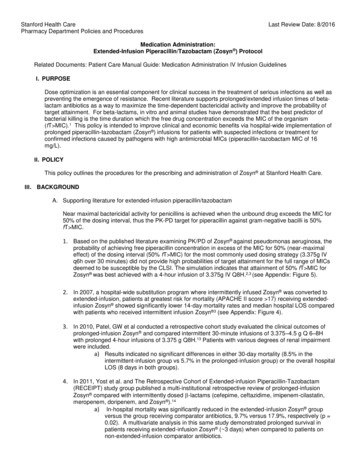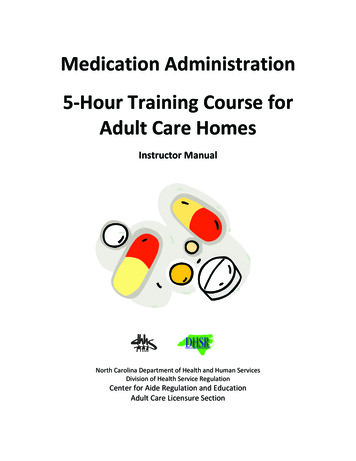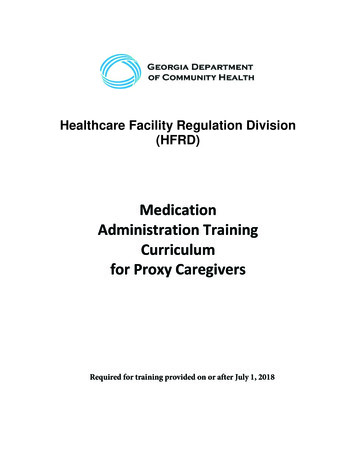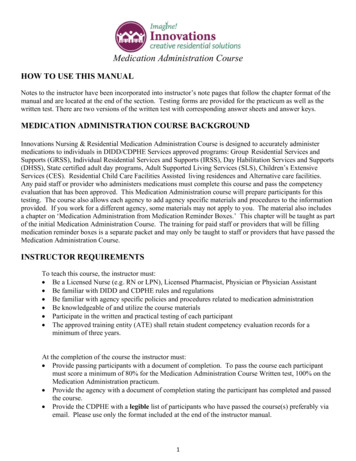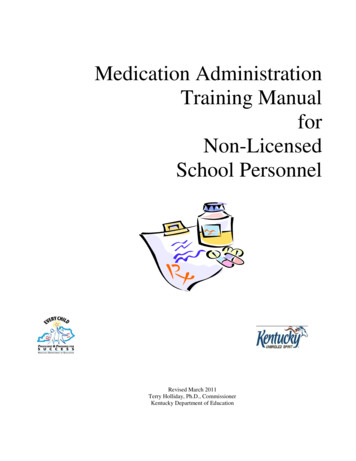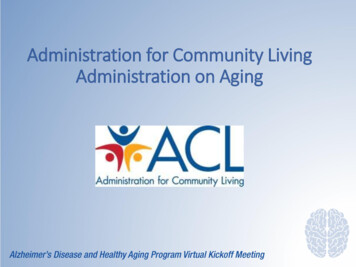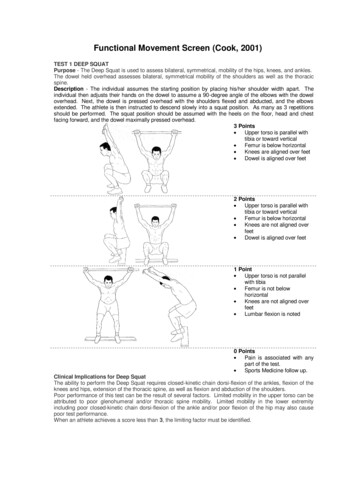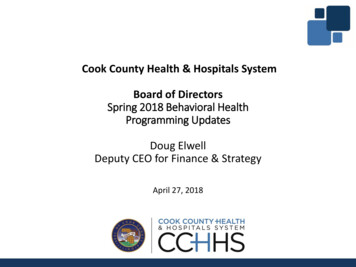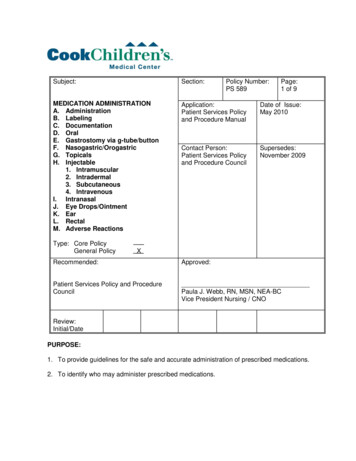
Transcription
Subject:Section:MEDICATION ADMINISTRATIONA. AdministrationB. LabelingC. DocumentationD. OralE. Gastrostomy via g-tube/buttonF. Nasogastric/OrogastricG. TopicalsH. Injectable1. Intramuscular2. Intradermal3. Subcutaneous4. IntravenousI. IntranasalJ. Eye Drops/OintmentK. EarL. RectalM. Adverse ReactionsApplication:Patient Services Policyand Procedure ManualDate of Issue:May 2010Contact Person:Patient Services Policyand Procedure CouncilSupersedes:November 2009Type: Core PolicyGeneral PolicyPolicy Number:PS 589Page:1 of 9XRecommended:Approved:Patient Services Policy and ProcedureCouncilPaula J. Webb, RN, MSN, NEA-BCVice President Nursing / CNOReview:Initial/DatePURPOSE:1. To provide guidelines for the safe and accurate administration of prescribed medications.2. To identify who may administer prescribed medications.
MEDICATION ADMINISTRATIONA.PS 589Page 2ADMINISTRATIONNote: Preop antibiotics should be given at the appropriate time prior to surgery start time toprovide optimum protection from surgical site infection. See “Label Comments” on the onlineMAR (OMAR) for administration and infusion instructions of the preop medications.1.Use the verified MAR or physician order to select medications from the patient’smedication box or automatic dispensing unit.2.Check the administration time. It may be necessary to administer PRN pain medication15-30 minutes prior to the prescribed administration time in order to provide adequatepain control for a patient before or after receiving a therapy/procedure. Earlyadministration of pain medication should be limited to once a shift. If the patientdemonstrates inadequate pain control with the prescribed time interval, thephysician/provider should be contacted for additional pain control orders.3.Verify the drug name, dose and route on the medication label with the MAR/ physicianorder.4.Identify the patient by matching patient demographics on MAR/ physician order topatient’s ID. (See Patient Identification - PS 037) Patient and medication identificationlabels are used for verification at the bedside.5.Check the Allergy status.6.Other considerations7.a. Patient medications labeled as “Guardrail Required” must be infused using aSmartpump utilizing the Guardrail library (Exception: during a medical emergency ora code or when the delay in obtaining a Smartpump pump would harm the patient.)b. Prior to administration, the following high risk medications are checked by twolicensed nursing personnel or authorized personnel with demonstrated anddocumented competency. Two personnel verification is defined as: 1. Verification ofmedication administration record; 2. Verification of physician order with continuousinfusion; 3. Dose, and that it is appropriate for the patient’s weight; 4. Correct rate ofadministration; and 5. Correct rate is programmed into the IV pump. The secondnurse verification requires the second nurse to go to the bedside to verify that the IVpump programming and rate settings are accurate. The primary nurse responsiblefor the medication administration will ensure that the nurse that double checked themedication is the co-signer in the medical record and narcotic record whenapplicable. For rate or dose changes with continuous drips, the primary nurseresponsible for the medication administration will document the licensed personnel’sname that verified the medication and rate. For chemotherapy administration, alsoreference the policy on Antineoplastics, PS 637.1) Antiarrhythmic drugs2) AnticoagulantsHeparin* concentrations greater than 100units/ml for central lines* concentrations greater than 10units/ml for peripheral IV flush3) Hyperalimentation
MEDICATION ADMINISTRATIONPS 589Page 34)5)6)7)8)9)Chemotherapy (administered by Chemotherapy certified nurses only)NubainInsulinNarcoticsIV Electrolytes excluding IV Fluid admixturesKetamine- can only be administered by RNs with completed moderate sedationcompetency in PICU and ED, as well as minor procedure-RNs in the OR10) Vasoactive drips11) Milrinone drip12) Alprostadil drip13) Terbutaline drip14) Ethanol Lockc. The two (2) authorized Personnel will sign off medication on the MAR or appropriatenursing record after administration. (TPN order sheet or diabetic flowsheet forinsulin, etc.)d. The nursing orientee will check all medications with the preceptor for the agreed time(see Medication Agreement Attachment II). In the event of a medication error theoccurrence will apply to the orientee and the preceptor.e. The graduate nurse (GN) should not give medications unsupervised by his/herpreceptor until notification of passing his/her NCLEX.f.IVPB/Autosyringe (Intravenous Piggyback/Autosyringe) medications are given byRN’s and LVN’s with demonstrated and documented competency.g. IVP (Intravenous Push) medications are given by RN’s and qualified LVN’s who havedemonstrated and documented competency.h. Licensed radiology personnel who have demonstrated and documented competencymay administer IV contrast for diagnostic procedures. Documentation of this will bedone in the radiology report.i.Licensed respiratory personnel (RRT, CRT) who have demonstrated anddocumented competency, and have passed a medication calculation test mayadminister by inhalation opioids for dyspnea or pain control, e.g., morphine, fentanyl,hydro morphine or furosemide, or other inhaled medications ordered by a physician.j.All staff who will administer medications will complete and pass a medicationcalculation test prior to administering medications.k. Self or parent/caregiver administration of meds is allowed when preparing a patientfor discharge. If there are medications that require special instructions related toadministration, a competent parent/caregiver or patient may be allowed to administerthe medication(s) under the supervision of the nurse prior to discharge. Educationwill include nature of the mediation(s) to be administered, how to administer themedication(s) including frequency, route, dose, the expected actions and side effectsof the medications to be administered and how to monitor the effects of themedication(s) on the patient. Documentation will include the above elements (eitherspelled out or in summary based on policy statement), evaluation of theparent/caregiver’s or patients ability to administer through return demonstration or
MEDICATION ADMINISTRATIONPS 589Page 4other appropriate method. Entry on the MAR should note that the medication wasadministered by parent/caregiver or patient.l.When administration of medication(s), including subcutaneous injections of certainmedications (i.e. growth hormones, insulin), has been determined appropriate tofacilitate participation in care of the patient (e.g. parent provides primary care athome and medication routine is continued in the hospital), there will be verificationthat parent/caregiver/patient understands the nature of the medication(s) to beadministered, how to administer the medication(s) including frequency, route, dose,the expected actions and side effects of the medication(s) to be administered, andhow to monitor the effects of the medication(s) on the patient. Documentation willinclude verification of the above elements (either spelled out or in a summary basedon policy statement), evaluation of the parent’s or patient’s ability to administerthrough observation or other appropriate method. Entry on the MAR should note thatthe medication was administered by parent/caregiver or patient.m. When there is increased compliance with parent assisting in oral medicationadministration and select topical medication applications, the medicationadministration may be performed by a parent with supervision and documentation bynursing staff. Medications would include those that could be provided safely in thehome setting. After documentation of appropriate teaching, subcutaneous injectionsmay be given by the parent. No IV or IM meds will be administered by parents. Forthis purpose education is required because the medication type and routes arelimited and staff will monitor all aspects of medication administration including effectof medication.NOTE: Each orientee will be given three opportunities to score 100%. If the orientee doesnot pass the first test, they will retest within one week. The orientee will not beallowed to retest on the same day. The orientee’s learning needs will be assessed bythe educator and individualized tutoring will be offered. If a second attempt isunsuccessful, he/she will retest within one week.If the orientee does not score 100% on the third test, formal review process willfollow. The review committee will consist of an educator, the Assistant VicePresident of education, the Director of Employee Relations and the Director of theorientee’s department. This review could result in termination or a final opportunity totest. The fourth test must be completed within one week of the formal review. Failureto successfully pass the fourth test will result in termination.B.LABELINGA standardized method for labeling all medications will minimize errors. Anytime one ormore medications are prepared but are not administered immediately, the medicationsyringe/vial will be labeled with drug strength, date, time and secured in such a way thatit can be readily determined that the contents are intact and have not expired.At a minimum, all medications are labeled with the following:Drug name, strength, and amount (if not apparent for the container)Expiration date when not used within 24 hoursExpiration time when expiration occurs in less than 24 hoursFor all compounded IV admixtures and parenteral nutrition solutions, the dateprepared and the diluents
MEDICATION ADMINISTRATIONPS 589Page 5When preparing medications for multiple patients or the person preparing themedications is not the person administering the medication, the label also includes thefollowing:Patient namePatient locationIn surgical or other procedural settings (OR, prep areas, pre-op holding, PACU,medications used by anesthesia providers, radiology and other imaging services,endoscopy units, dental services, and patient care units) where “bedside” procedures aredone, when medications are drawn up and put on the sterile field for use during thatspecific procedure, at a minimum, the label will include the following:Medication nameMedication strengthMedication amount (if not apparent from the container)Expiration date is required if the medication will not be used within 24 hours.Expiration time is required if the expiration will occur in less than 24 hours.Date prepared and the dilutent for all compounded IV admixturesIn most cases of medications and solutions in the procedural setting, only the drug name,strength (concentration), and amount will be needed.Any remaining medication must be discarded immediately after the case / procedure withthe emergency drugs available in the OR / Perioperative areas. They may be discardedat the end of the day.It is acceptable to purchase and use pre-filled, pre-labeled syringes such as on proceduretrays. However, pre-labeling medication and solution containers is not acceptable. Thelabel should be prepared and applied at the time the medication or solution is prepared.If, during the peri-operative or peri-procedural process, a solution or medication (either inthe sterile field or out) is poured, drawn into a syringe, or otherwise used from it’s originalcontainer and immediately administered, or disposed of in some fashion, labeling is notrequired.Whenever removing medication/solutions from original container, the original containermust be kept in the room for the procedure. If the medication or solution that has beenremoved from its original container will be used over the course of a procedure, forinstance – prep solutions, normal saline used to rinse cardiac valves, local anesthetics,clotting agents, etc. their receiving container must be labeled.C.DOCUMENTATION - See MAR (PS 586) for guidelines.D.ORAL MEDICATIONS1.Use oral syringe and syringe dispenser cap to withdraw liquid oral medications frommulti-dose bottles.2.If necessary crushed pills may be mixed with water, syrpalta or appropriate food.Pharmacy may be consulted to determine if crushing is appropriate foradmixture methods and compatibilities.
MEDICATION ADMINISTRATIONE.F.PS 589Page 6GASTROSTOMY VIA G-TUBE / BUTTON1.Draw up medication as described in B. Oral Medications.2.Considerations for special instructions such as "take on empty stomach “or "takewith food/plenty of liquids" should be considered.3.Attach the barrel of the syringe to the feeding catheter / g-button and slowly injectmedication.4.Clear the catheter / g-button with water.a. Neonate - 3mlb. Infant – 5mlc. Child greater than 1 yr – 10mld. Adolescent - up to 30mle. Or per physician orderNASOGASTRIC/OROGASTRIC TUBE1. Refer to Nasogastric/Orogastric Tube policy, PS 555 for checking proper placementof the nasogastric or orogastric tube.2. Crush solid medications that are not sustained-release preparations into a finepowder with a pestle or pill crusher. Mix in a small medicine cup with up to 10ml ofwarm solution (i.e. formula or water).3. Draw up the solution into an oral syringe and label appropriately. Avoid usinghypodermic syringes to avoid inadvertent IV or IM administration of medication.Clear the syringe of excess air.4. Unclamp tube and prepare for administration of medication after placementverification.5. Attach syringe to desired tube port and instill medication by slowly and steadilypushing on the plunger.6. Follow administration of medication with flushing tube with 1-10ml of diluent flush. Airmay be used to flush if potential for fluid overload exists, but potential for cloggingthe tube exists.7. Clamp the gastric tube for approximately 30 minutes after medication administrationif the tube is not in continuous use.8. Troubleshoot clogged tube: Remove the syringe with medication and attach a 60mlsyringe to the NG tube port. Aspirate gently and then apply light pressure to theplunger. May repeat several times. If this does not clear the tube, remove the tubeunless contraindicated (i.e. GI surgery). Attempt to identify why the tube clogged toavoid repeating the process. Possible problems may include:a.b.c.d.Medication was incompatible with the diluent.Tube was not flushed adequately when previous medications wereadministered.Food-medication interactionDrug-drug interaction
MEDICATION ADMINISTRATIONG.PS 589Page 7TOPICALS1. PRN topical may be left at the bedside. Denote “at bedside” in appropriate columnon MAR.H.INJECTABLE MEDICATIONS:If injectable medication is not prepared by pharmacy, mix as directed and draw up in asyringe using aseptic technique. Consult package insert and/or label directions, asreference for specific instructions on mixing and administration.1. IV bags and bottles should be labeled with type of IV fluid. When medications areadded, the drug name, dose, date, time and staff initials will appear on the label.2. A filter needle will be used to draw up medications supplied in ampules.3. For multiple dose vials, label vial with patient’s name, date and time reconstituted.4. Use a tuberculin syringe to draw up doses less than one (1) ml in volume.5. Insulin syringes may only be used for administration of insulin.6. Intramuscular Injections:a.Guidelines for Needle size-amount of injection:The smallest needle which is adequate in both gauge and length will cause theleast injection site trauma. Needle length may vary according to the amount ofsubcutaneous tissue present.Infants: A 25 gauge, 5/8 or a 23 gauge, 1 inch size is preferred. The musclemass of small infants usually cannot tolerate more than 0.5 ml of medication.Toddlers: A 22 gauge, 1 to 1½ inch needle is usually acceptable. Themaximum amount to be injected into any one site is 1 ml.Older Age Groups: Needle size as for toddler; the maximum amount into anyone site is 2 ml.Adolescents/Adults: A 22 gauge, 1 to 1 ½ inch needle. If amount of injectionis greater than 2 ml, the ventrogluteal site should be used.b.Select injection site, rotating among acceptable pediatric muscle groups.Age: Less than 5yrs – lateral and anterior aspect of the thigh.Greater than 5yrs – Dorsogluteal (if well developed), ventrogluteal,deltoid, lateral thigh and anterior thigh.(See Attachment I)7.Intradermal Injections:To administer: The medial surface of the forearm is the most common site foradministration. A 25 gauge, 5/8 inch needle should be inserted, bevel up, at a 15
MEDICATION ADMINISTRATIONPS 589Page 8degree angle. No more than 0.1 ml should be injected. A small bleb will form as thefluid is injected.8.Subcutaneous Injections:To administer: Use a 26 gauge, 3/8 inch needle or a 25 gauge, 5/8 inch needle.Never give more than 0.5ml to the small child and 1.0 ml to the older child in any oneinjection. Rotate site frequently.9.I.Intravenous Medication:a.If medication is not reconstituted by pharmacy, mix medication as directed anddraw up in a syringe using sterile technique.A filter needle must be used to draw up medications supplied in ampules.b.Administer medication by syringe pump infusion method, piggyback method orpush method as applicable.c.When two or more drugs are to be given by IV check for compatibility prior toadministration. If medications are incompatible, flush with N/S or appropriatesolution before and after administration.INTRANASAL MEDICATIONSFollow manufactures instructions, physician orders, pharmacy instructions for medicationdispensed in nasal spray pumps. Have bulb syringe available to suction patient’s naresbefore instillation if necessary.J.EYE DROPS OR OINTMENT1. Position patient in a supine position for proper instillation and to preventcontamination of dropper on tube. Use an assistant as needed.2. Pull the lower lid down and out to form a cup.3. Drop the solution into the cup. The medicine will enter the conjunctiva. Close the eyegently.4. Ointments should be applied along the inner canthus in an outward direction.5. Avoid touching the tip of the dropper or ointment tube to the body.K.EAR DROPSPosition patient with affected ear at appropriate angle prior to instillation.a. Infants and children less than 3 years, pull ear slightly down and straight back.b. Patient more than 3 years pull ear up and back.Attempt to keep child in same position as instillation for a few minutes to allowmedication to enter ear canal.
MEDICATION ADMINISTRATIONL.RECTAL MEDICATION1.M.PS 589Page 9Place child in a side-lying or prone position2.Lubricate suppository or rectal tube with water soluble jelly prior to administration.3.Gently insert the suppository into the rectum. Do not insert more than ½ inch.ADVERSE REACTIONSAdverse Drug Reaction: Any reaction to a drug that is undesirable, unexpected, andoccurs at doses normally used for the prevention, diagnosis, or treatment of disease.All adverse medication reactions or suspected medication reactions are reported to thePhysician, Nurse Manager/Charge Nurse and Pharmacist. An adverse reaction isreported to the Pharmacy by filling out the Adverse Drug Reaction Notification Form(Attachment IV) or by calling 2-ADR (x2237). Pharmacy will enter documentation intomedical record upon notification. For vaccine adverse event, complete form and route topharmacy or phone the pharmacy. (Vaccine Adverse Event Reporting Form –Attachment III)Immunization Reactions are to be reported on a vaccine adverse event form as perPS 095, Immunizations.Combined PS 040 (Medications: Administration of Medications and Reporting ofErrors/Adverse Reactions) and PS 589 (Medication Administration) in November 2000.ORIGINAL DATE: March 1982 (PS 040), (PS 589)REFERENCE:Bowden, Vicky R., Greenberg, Cindy Smith. Pediatric Nursing Procedures. HippincortWilliams & Wilkins. 2003. Chapter 62.Bowden, V., Greenberg, C. Pediatric Nursing Procedures. 2008. Pp 415-418.The Joint Commission FAQs for 2008 National Patient Safety Goals. Updated 3/08 –published 6/24/08.Nicoll, Leslie H. and Hes
Jun 24, 2008 · RN’s and LVN’s with demonstrated and documented competency. g. IVP (Intravenous Push) medications are given by RN’s and qualified LVN’s who have demonstrated and documented competency. h. Licensed radiology personnel who have demonstrated and documented compete
